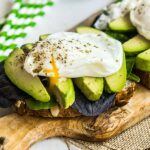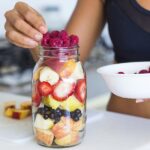
Electrolyte Balance Guide: The Secret to True Hydration (Water + Salt)
We’ve been told our whole lives: “drink 8 glasses of water a day.” We assume hydration is just about drinking plain water. But what if I told you that drinking water alone isn’t the answer to optimal hydration? And what if, in some cases, it could even be counterproductive?
True hydration isn’t just about water volume; it’s about balance. Specifically, the balance between the water we drink and the salt (electrolytes) we consume.
Your Body’s Internal Ocean
Think of it this way: the fluid running through your veins and bathing your cells (the extracellular fluid) isn’t pure water. It is, in essence, an internal ocean. It’s a saline solution containing sodium, potassium, magnesium, and other vital electrolytes.
How saline? The concentration of Sodium Chloride (NaCl) in the fluid surrounding our cells is approximately 9 grams per liter of water.
The Body’s Electrical Grid: The Brain and the Heart
This salinity isn’t an arbitrary detail. Why is it so vital? Because this saline solution is your body’s electrical grid.
When salt (an electrolyte) dissolves in water, it separates into ions (like Sodium, Na+) that carry an electrical charge. Literally, your entire nervous system runs on this electricity.
- The Brain: Every thought, every memory, every command sent to your muscles is a small electrical current (an action potential) traveling through your neurons.
- The Heart: The heartbeat is a precise, rhythmic electrical wave. This wave travels through the heart tissue thanks to the conductivity provided by the electrolytes in the fluid bathing it.
When this balance is broken by a lack of electrolytes (dilution), the electricity weakens. Signals become slow or erratic. This is the direct root of serious problems:
- Mental Issues: “Brain fog,” confusion, lack of concentration, dizziness, or depression. The brain simply doesn’t have the electrical charge it needs to function clearly.
- Cardiac Issues: Arrhythmias, palpitations, or weakness. The heart “loses its rhythm” because the electrical signal ordering it to beat has become weak or chaotic.
Maintaining water and salt balance isn’t just about “not being thirsty”; it’s about keeping the electricity flowing and allowing your brain and heart to function.
All Fluids Count
It’s crucial to understand that when we talk about “total fluid,” we don’t just mean plain water. It’s everything you drink: your morning coffee, your evening tea, that glass of wine, the soup at lunch, and even the water contained in the fruits and vegetables you eat (a salad is almost all water!). Your body processes all of this fluid.
The clearest proof is the IV bag you get at a hospital. “Physiological saline” is not distilled water; it’s a 0.9% saline solution (9 grams of salt per liter). This is the ratio your body recognizes as its own. If a nurse injected you with pure water (no salt) into your veins, your cells would swell, the electricity would fail, and you would die. This gives us the biggest clue: our body runs on salt water.
The Balance Manager: The Kidney
This is where the kidney comes in. The kidneys are the incredibly intelligent managers of this balance. Their main job, part of the complex renal physiology, isn’t just filtering toxins; it’s maintaining this concentration of salt and water (and thus, electricity) in a perfect range.
- If you eat a lot of salt and drink little water, your kidneys will excrete very concentrated (yellow) urine to get rid of salt and conserve water.
- If you drink a lot of water and eat little salt, your kidneys will excrete very dilute (clear) urine to get rid of water and conserve salt.
The problem of hyponatremia (low blood sodium) occurs when we overwhelm the kidney’s capacity. This happens to athletes who drink liters of plain water: they sweat out salt, replace it only with water, and dilute their blood to dangerous levels.
Why 5 Grams of Salt Isn’t the Same for Everyone: Two Opposite Examples
This is where public health guidelines, like the WHO’s recommendation of “a maximum of 5 grams of salt per day,” can be misunderstood. That guide is a limit to prevent excess, not a target for optimal hydration in all situations.
Let’s look at two opposite cases suffering from imbalance:
Example 1: The “Healthy Hydration” Vicious Cycle (Dilution)
A woman who goes to the gym 4 times a week and sweats. She eats “healthy”: chicken and salad. She drinks 4 cups of coffee (1 L), 2.5 Liters of “extra” water, and one tea (0.25 L). The water from her food is ~0.75 L.
- Total Fluid Intake: ~4.5 Liters.
- Total Salt Intake: She follows the WHO guide and limits herself to 5 grams.
Her Real Ratio: 5 grams of salt / 4.5 Liters of fluid = 1.11 grams of salt per liter.
Her body, trying to maintain an internal balance of ~9 g/L, is receiving fluid that is only 1.11 g/L. She is in a state of chronic dilution. This weakens her “electrical grid,” which can lead to sugar cravings (hypoglycemia), headaches, fatigue, hair loss, water retention (cellulite), and chronic exhaustion.
Example 2: The “Processed Food” Vicious Cycle (Concentration)
Now let’s look at the opposite case: a sedentary person, overweight, who doesn’t exercise. They might only drink 1 liter of total fluid per day (sodas, a coffee, little water). Their diet is based on processed foods high in sodium:
- Breakfast: Bread with cold cuts (ham, sausages) (900mg Na)
- Snack: Chorizo (600mg Na)
- Lunch: Sausages with condiments (1800mg Na)
- Total Sodium Ingested: ~3,300 mg of Sodium.
Total Salt Ingested: 3,300 mg Na / 400 = 8.25 grams of Salt.
His Real Ratio: 8.25 grams of salt / 1 Liter of fluid = 8.25 grams of salt per liter.
This person is on the opposite end: chronic concentration. Their ratio of 8.25 g/L is far above the ideal 5 g/L. Their body is forced to retain that small amount of water to try and dilute the salt, which increases blood volume and triggers high blood pressure (hypertension).
Both individuals are unbalanced and unwell, but for opposite reasons. The key isn’t just “drink more water” or “eat less salt.” The key is the ratio.
Electrolyte Balance Guide
(The 5g/L Synchronized Method)
This method is based on three key principles:
- Follow Your Thirst: Thirst is your primary guide. You should not drink water “just to drink it” or out of habit; drink when your body asks for it. The body regulates the need for fluid.
- The Ratio (5g/L): Every time you drink fluids (driven by thirst), you must achieve a balance of 5 grams of salt (NaCl) for every liter of total fluid consumed.
- Synchronization: Consume the corresponding salt at the same time (or very close to) the fluid intake, so the kidneys process the fluid and electrolytes as a balanced set.
Step 1: Quantify Total Fluids (24-hour Target)
Record all fluid you ingest when you decide to drink (following your thirst):
- Beverages: Water (plain/sparkling), coffee, tea, milk, juices, sodas, wine, etc.
- Liquid Foods: Soups, broths, smoothies.
- Water in Solid Foods: Estimate the water in fruits and vegetables (e.g., 100g of cucumber ≈ 95 ml of fluid).
Action: Add all these volumes to get your Total Liters (L) for the day.
Step 2: Calculate Your Salt Target (g)
The base formula is as follows:
- Formula: (Total Liters) x 5 = Grams of Salt Required.
- Example: 2.3 Total Liters = 11.5 grams of salt (NaCl) as a daily target.
Step 3: The Synchronization Principle (The Key Point)
The balance isn’t calculated at the end of the day, but in real-time.
- The Logic: The kidneys adjust fluid and salt balance immediately. If you drink fluid without the corresponding salt, the body will register it as excess water (an imbalance) and the kidneys will excrete it quickly (urine).
- Practical Example:
- If you drink 2 cups of coffee (500 ml), this fluid requires 2.5 grams of salt (based on the 5g/L ratio) to be in balance.
- Action: You must consume those 2.5 g of salt before, during, or immediately after drinking the coffee.
- The Error to Avoid: Taking those 2.5 g of salt at night. By then, you have already urinated several times; the body has already “discarded” the morning’s fluid.
Action: Every time you ingest a “block” of fluid (your coffee, a bottle of water), you must accompany it with the proportionally corresponding salt.
Step 4: Quantify Salt from Food
Track the salt (NaCl) that is already in your food.
- Processed Foods: Check the labels.
- Added Salt: The salt you use for cooking or at the table.
Critical Instruction: Salt (NaCl) vs. Sodium (Na) Food labels do not list “Salt,” they list “Sodium.” This conversion is essential for the calculation to work:
- 1 gram of Salt (NaCl) ≈ 400 mg of Sodium (Na)
Therefore, this method’s ratio (5g of Salt/L) is equivalent to 2,000 mg of Sodium/L. If your 500 ml of coffee requires 2.5 g of Salt, that is equivalent to 1,000 mg of Sodium.
Our CaloriTrack app makes this process easier by automatically calculating the sodium in the foods you log.
Step 5: Adjust for Exercise and Sweat
Exercise requires a special adjustment.
- Quantify Loss: The most accurate method is to weigh yourself immediately before and immediately after exercise (without clothes or in the same dry clothes).
- Example: If you weigh 0.8 kg less after training, you have lost approximately 0.8 Liters (800 ml) of sweat.
- Replenish Fluid: You must replenish that amount of lost fluid (e.g., 800 ml).
- Replenish Salt (The Ratio): Sweat is water with salt. Apply the same 5g/L ratio to the fluid lost through sweat.
- Example: 0.8 L of sweat lost x 5 g/L = 4 additional grams of salt that you must consume along with the replacement fluid.
- Listen to Your Body: In addition to the calculation, listen to your thirst. A salt-water-lemon “serum” is an ideal vehicle for this post-exercise replenishment.
Step 6: Adjust and Supplement (In Real-Time)
This step combines everything:
- You are about to drink 500 ml of water (Step 1).
- You calculate that you need 2.5 g of salt (Step 2 & 3).
- You decide to eat a snack that, according to the label, has 400 mg of Sodium (which is 1.0 g of salt) (Step 4).
- Action: You are still 1.5 g of salt short for that block of water. You must supplement those 1.5 g at that moment (e.g., by taking a small sip of your salt and lemon serum, or with lemon and salt).
Handling Excess Salt and Detox
As you adjust your salt intake, pay attention to your body’s signals:
- Rapid Detox (Diarrhea): If you experience diarrhea, it is a sign that you consumed too much salt at once. This is a rapid detox where the body is flushing out the excess and water from the cells. If this happens, lower your intake by one gram of salt per liter (i.e., aim for a 4g/L ratio) and adjust from there. If it continues, lower it again, but never go below 2 grams of salt per liter.
- Normal Adjustment: A less aggressive detox process, or simply the daily management of excess fluids, will manifest naturally. The body will excrete excess water through urine, sweat, and respiration.
⚠️ Contraindications and Precautions
Disclaimer: This is a specific hydration protocol that results in a high sodium intake. It is not a general health guide and can be extremely dangerous for certain individuals.
DO NOT FOLLOW THIS PROTOCOL if you fall into any of the following categories:
- Individuals with Hypertension (High Blood Pressure):
- Why: This protocol is based on increasing salt (sodium) intake. For most people with hypertension, excess sodium can dramatically raise blood pressure to dangerous levels.
- Individuals with Kidney Disease (Renal Insufficiency):
- Why: This protocol assumes healthy kidney function. The kidneys of a person with kidney disease have lost their regulatory ability and cannot efficiently excrete excess salt. This can lead to fluid and sodium overload, causing severe edema and cardiac complications.
- Individuals with Congestive Heart Failure (CHF):
- Why: Sodium causes the body to retain water. In a person with a weakened heart (CHF), this extra fluid increases the blood volume the heart must pump, placing an unsustainable strain on it.
- Other Medical Conditions:
- Anyone with pre-existing medical conditions, especially those related to the heart, liver (like cirrhosis), or who are taking diuretic medications.
Final Recommendation: Always consult your doctor before starting this or any other protocol that drastically alters your electrolyte intake. Only a health professional who knows your medical history can determine if this approach is safe or appropriate for you.
Supporting Scientific Links and References
Physiology, Action Potential (NIH) A scientific explanation of how voltage-gated sodium channels (Na+) initiate the action potential (the electrical impulse) in neurons and muscle cells. https://www.ncbi.nlm.nih.gov/books/NBK538143/
Cardiac Sodium Channels: Structure and Function (NIH) A review article detailing how the opening of the cardiac sodium channel “initiates cell depolarization and the propagation of an electrical action potential that promotes coordinated heart contraction.” https://pmc.ncbi.nlm.nih.gov/articles/PMC5398315/
Hyponatremia – Symptoms and causes (Mayo Clinic) A medical resource defining hyponatremia (low sodium) and listing its symptoms, including “Headache, Confusion, Loss of energy, drowsiness and fatigue.” https://www.mayoclinic.org/diseases-conditions/hyponatremia/symptoms-causes/syc-20373711
Salt and Sodium (Harvard T.H. Chan School of Public Health) An article explaining the role of sodium in nerve impulse transmission and muscle contraction, and detailing its link to high blood pressure (hypertension). https://www.hsph.harvard.edu/nutritionsource/salt-and-sodium/
Normal Saline (StatPearls – NIH) A technical medical article defining “Normal Saline” as a 0.9% Sodium Chloride solution, confirming it contains 9 grams of salt per liter and is used to expand extracellular fluid volume. https://www.ncbi.nlm.nih.gov/books/NBK545210/












